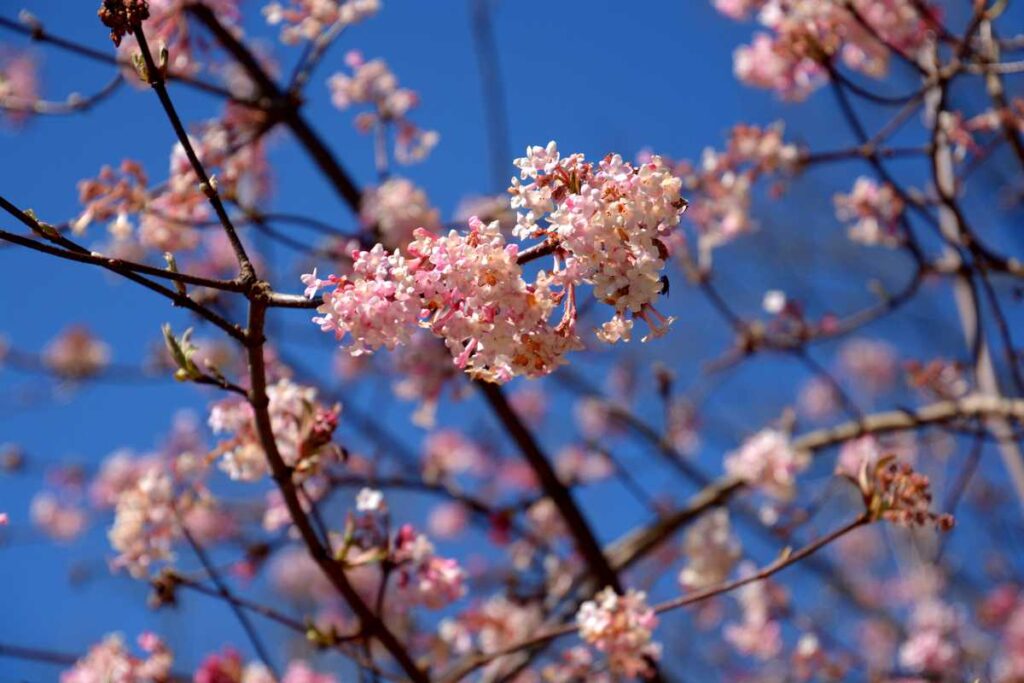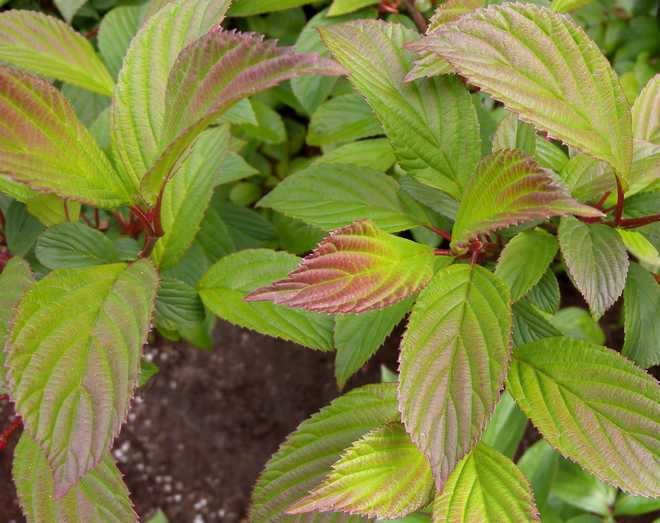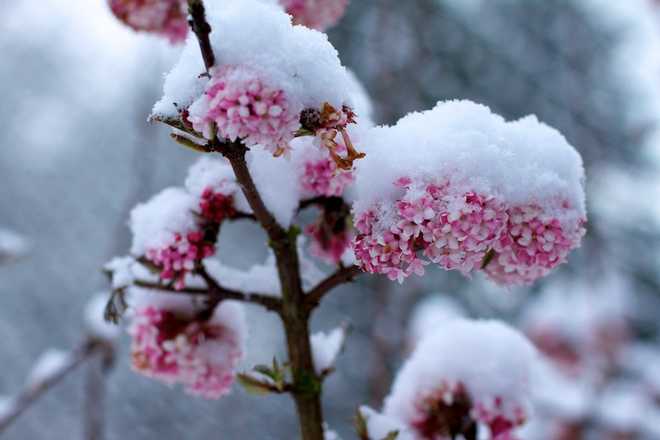
Bodnant viburnum is a member of the deciduous viburnum family like the obier viburnum. Easy to grow and undemanding, this fragrant winter-flowering shrub is most appealing from fall to late winter. The rest of the year, its dark green foliage still provides an interesting background to use to showcase the summer bloom of other nearby shrubs.
What there is to know :
Botanical name: Viburnum x bodnantense
Common name: Bodnant viburnum, winter viburnum
Family: Adoxaceae
Height x Spread: This fast growing viburnum features a slender figure. It is a shrub with a shrub-like habit, with large branches reaching 2 to 3 m in height.
Foliage: Deciduous. The oval leaves, pointed at the tip, toothed, a beautiful dark green, are shiny above, paler on the reverse. They color in the fall, turning orange, then red or purple just before falling. They appear in April, when flowering is over. When you crumple them, they give off a slight fragrance.
Flowers and Fruit: The small, pinkish-white, tubular flowers, united in clusters, bloom at the tips of bare twigs for several months, from November to March. They are very beautiful: red in bud, depending on the variety, they become intense pink then white. Despite the cold, they are not destroyed by periods of frost. They also diffuse a delicate fragrance in the heart of winter, especially as the climate is mild.
Exposure: In the sun, but not too hot, or in partial shade, sheltered from the winds.
Soil: Not very demanding. This shrub grows in all soils, even a little chalky. However, he appreciates a rich, fresh and deep soil.
Hardiness: Resists cold well down to -25 ° C if the soil is sufficiently drained.

When to plant winter viburnum?
Plant Viburnum x bodnantense in early spring or fall. Choose a plant that is raised in containers, taking the time to check under the pot that its roots are not sticking out excessively and that they have not curled up on themselves. More rarely, we also find this plant with bare roots. It is then planted in late autumn.
Place it in good garden soil mixed with a few handfuls of compost.
Maintenance of Viburnum bodnantense
Resistant to pests and diseases, not very sensitive to urban pollution and rather hardy, this winter shrub is also easy to maintain.
Pruning: The winter viburnum does not need pruning for the first 3 years after planting, the time for it to develop its shrubby habit. In the following years, a slight regular pruning is carried out each year after flowering, in early spring. It consists of :
- Shorten the twigs that have just bloomed by half
- Remove dead wood and a few old branches that are cut low to the ground to ventilate the bush. Fertilizer: Feed the shrub stems with a generous amount of compost every 2-3 years.
Watering: Regular watering is very important during the year of planting, especially if the summer is dry, as this shrub needs cool soil. After 3 or 4 years, when the winter viburnum begins to bloom, it is no longer useful to give it water.
Bodnant viburnum in pot
It also grows very well in pots: you can therefore reserve a nice place for it on the terrace or on a balcony.

How to use it in the garden?
In the garden, it is best to plant it near the house or on a path to enjoy the powerful scent of its flowers.
You can also plant winter viburnum:
- In a free hedge, by associating it with deciduous shrubs such as flowering currants or evergreen such as bay laurel, another Viburnum. Both bloom at the same time.
- In a small grove or a light undergrowth, with rhododendrons or in association with Hamamelis.
- Isolated, in a bed, above a carpet of heather or early bulbs.
- Isolated on a lawn.
Remarkable winter viburnum varieties
There are a few beautiful varieties, all of which are hybrids:
- Viburnum bodnantense Dawn, with light pink flowers
- Viburnum bodnantense Charles Lamont, is the most common hybrid. This shrub with upright vegetation and bushy habit bears very fragrant and often very early dark pink flowers, from November. It grows well in all soils except acidic, overly compacted, or very wet soils.
- Viburnum bodnantense deben, whose pinkish-bench flowers bloom longer, but less hardy than the other two.
Fragrant flowers, but without nectar
Despite its interesting flowering period, the flowers of Bodnant’s viburnum unfortunately do not produce nectar and therefore do not nourish pollinating insects, so it is better not to abuse this shrub and always plan to combine it with more useful shrubs. .

